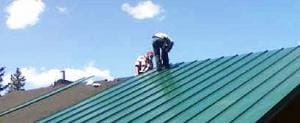One of the benefits of installing a metal roof on a structure is the low maintenance required to ensure a long life for the roof. Maintaining a metal roof is easy, as metal roofing is often referred to as maintenance-free.
In most cases a metal roof would retain structural integrity, remain leak-free, and look good for at least the life of the product warranty (generally 20-30 years for quality material) even without any maintenance.
 However, it is not a bad idea to perform a bit of routine inspection and preventive maintenance. This is especially important in areas that encounter frequent inclement weather.
However, it is not a bad idea to perform a bit of routine inspection and preventive maintenance. This is especially important in areas that encounter frequent inclement weather.
INSPECT ANNUALLY
Once a year you should inspect whole roof, area by area. Ensure you take routine safety precautions to prevent slipping or falling.
- Remove any debris – this helps prevent moisture and soil buildup, and reduces the chance of stains.
- Tighten any fasteners that may have loosened (unlikely, but it can happen, particularly if you’ve had a severe winter, or prolonged or intense winds).
- Inspect joints, penetrations, or other areas where sealant was used; apply fresh sealant to any spots where sealant appears to have been damaged or worn.
- If you notice any dirty, dusty or stained areas, a gentle washing is in order – as covered in the next section.
WASHING A METAL ROOF
If your area experiences particularly dusty, smoky, or smoggy conditions, you may notice a dirty or dusty film on the roof surface. This is extremely unlikely to harm the finish of most metal roofing, but it can detract from your roof’s appearance. Sometimes you will notice dust, dirt, or spots on just a small area of a roof. You can correct this simply by washing affected areas.
Washing a metal roof can be done as by spraying it with plain water using a hose or power washer.
For more resistant dirt, a soft bristle brush and a solution of water and detergent will normally do the trick. Trisodium phosphate (“TSP” – found in hardware stores), laundry detergent, non-abrasive all-purpose cleaners, or even liquid dish soap will work. The concentration to use depends on the product. Follow the directions on your product’s label to make a mild solution.
Do NOT use abrasive cleansers. Avoid using tools such as wire brushes, steel wool, or scouring pads that could scratch your metal roof’s protective coatings.
If you find spots of oil, grease, tar, excess caulk, or other such materials, they can usually be removed with a clean cloth and mild solvent such as mineral spirits. Follow up by washing the area with mild detergent, then rinsing with clear water.
MILDEW
In very humid areas mildew may in areas of a metal roof despite the high mildew resistance of quality paints and protective coatings.
If you do find mildew has developed, washing with a solution such as this should remove it:
- 1/3 cup detergent
- 2/3 cup trisodium phosphate (TSP)
- 1 quart of common chlorine bleach (5% sodium hypochlorite solution)
- 3 quarts of water
Once again, don’t use harsh solvents, abrasives, wire brushes and scouring pads.
DAMAGED PANELS OR TRIM
Occasionally a metal roof panel or piece of trim may be significantly damaged by a falling tree limb or some other serious impact. Dealing with such situations depends on the extent and nature of the damage. If you’re faced with a circumstance like this, you can generally contact a local contractor who specializes in metal roofing, or order a replacement part yourself from a reputable metal roofing materials source.
When locating the right replacement part, it is helpful if you know the manufacturer, roofing panel type, and color. If you don’t, the best idea is to measure the panel ribs peak-to-peak and provide that measurement. Also, you will want to provide a quality picture of your roofing panel. This is so that the supplier can better assist you with finding the right replacement panel or trim piece.





